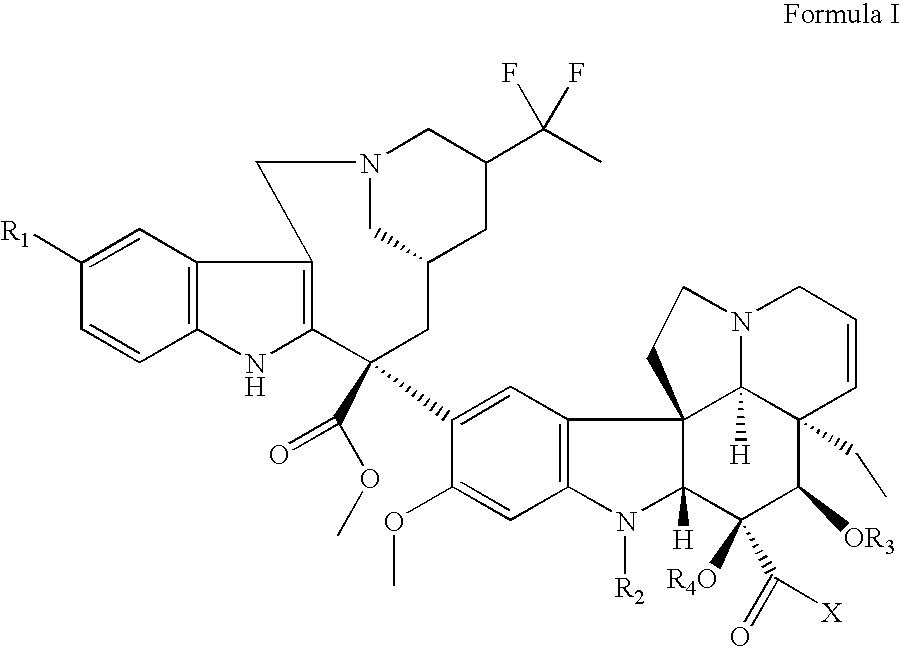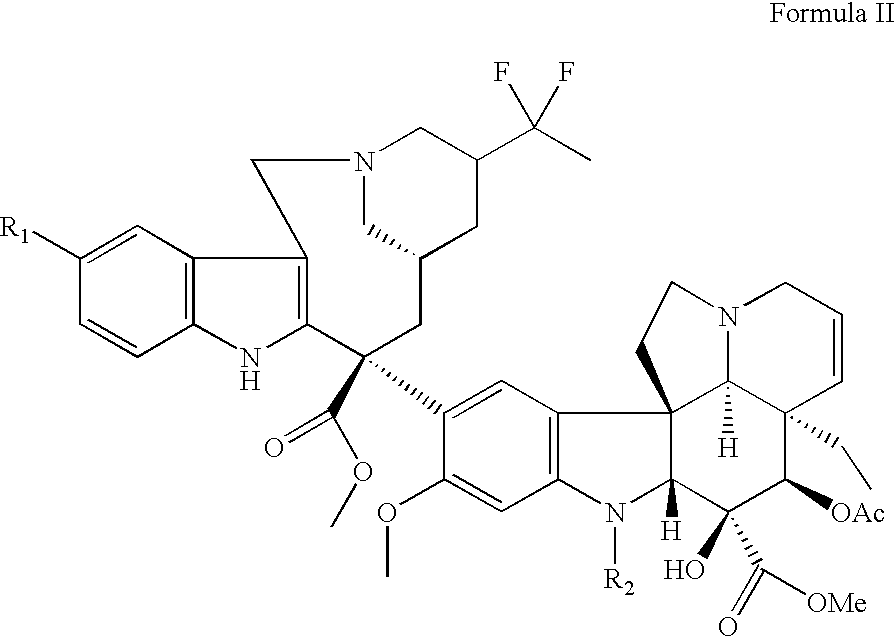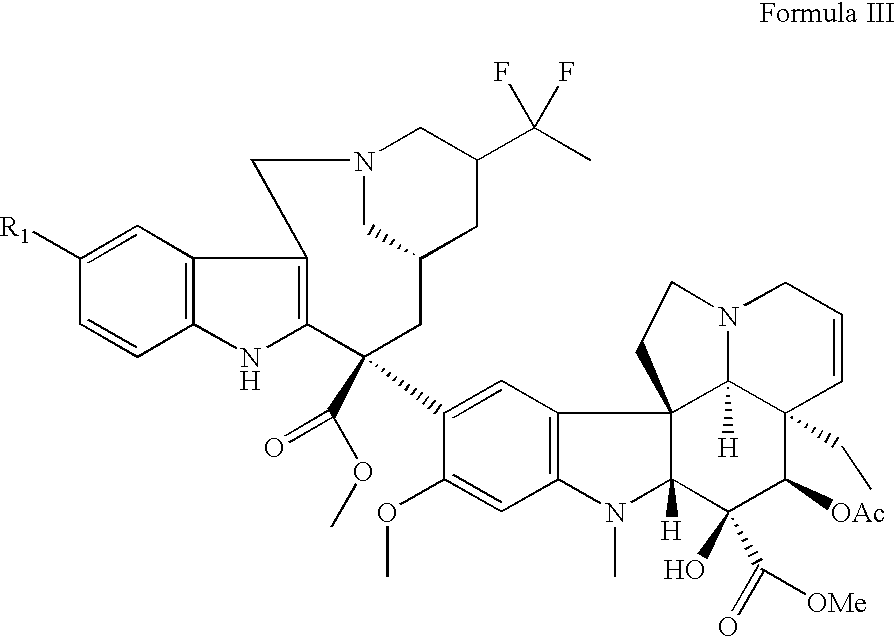Vinorelbine derivatives
a technology of vinorelbine and derivatives, which is applied in the direction of heterocyclic compound active ingredients, biocide, drug compositions, etc., can solve the problems of tumor formation, uncontrolled cellular proliferation, and tumor formation, and interfere with the dynamics of microtubule formation
- Summary
- Abstract
- Description
- Claims
- Application Information
AI Technical Summary
Benefits of technology
Problems solved by technology
Method used
Image
Examples
example 1
Preparation of 20′, 20′-Difluoro-3′,4′-dihydrovinorelbine (B)
[0352]This compound was prepared from 4′-deoxy-20′, 20′-difluorovinblastine (A) according to a reported procedure (U.S. Pat. No. 6,127,377, which is hereby incorporated by reference in its entirety), the spectral data of which were consistent with those reported therein.
example 2
Preparation of 20′,20′-Difluoro-3′,4′-dihydro-12′-iodovinorelbine (2)
[0353]20′,20′-difluoro-3′,4′-dihydrovinorelbine (B; bis-TFA salt; 250 mg, 0.24 mmol) was dissolved in MeCN (2 mL) and cooled to −15° C. Then conc. H2SO4 (0.30 mL) was added dropwise at −15° C. followed by dropwise addition of NIS (0.24 mmol) in MeCN (1 mL) at −10˜−15° C. The reaction mixture was stirred at −15˜−10° C. for 2 h, quenched with saturated NaHCO3 (10 mL) and extracted with EtOAc (3×10 mL). The combined extracts were dried over Na2SO4, filtered, and concentrated to give the crude title compound as a brown-yellow solid. Purification by column chromatography gave a white solid (134 mg, 59%): 1H NMR (500 MHz, CDCl3) δ 9.72 (s, 1H), 8.43 (s, 1H), 7.97 (s, 1H), 7.40 (d, J=8.3 Hz, 1H), 6.91 (d, J=8.4 Hz, 1H), 6.28 (s, 1H), 6.07 (s, 1H), 5.86-5.84 (m, 1H), 5.39 (s, 1H), 5.30-5.26 (m, 2H), 4.47 (d, J=12.6 Hz, 1H), 4.21 (d, J=12.6 Hz, 1H), 3.80 (s, 3H), 3.78 (s, 3H), 3.71 (s, 4H), 3.36-3.25 (m, 4H), 3.06-2.91 (m, ...
example 3
Preparation of 20′, 20′-Difluoro-3′,4′-dihydro-12′-methylthiovinorelbine (12)
[0354]This compound was prepared from 20′, 20′-difluoro-3′,4′-dihydro-12′-iodovinorelbine (2; 130 mg, 0.14 mmol)) and Pd(dppf)Cl2 (0.028 mmol) in NMP (2 mL) the mixture was degassed and purged with methanethiol three times. The reaction mixture was heated at 65° C. for 46 h. LC-MS analysis showed completion of the reaction. The reaction mixture was cooled to room temperature, diluted with EtOAc (15 mL) and washed with water (10 mL). The aqueous layer was extracted with EtOAc (2×10 mL). The combined organic layers were extracted with 0.5 N HCl (4×10 mL). The combined aqueous extracts were neutralized with NaHCO3 and extracted with EtOAc (4×15 mL). The combined organic layers were dried over Na2SO4 and concentrated. After purification by preparative HPLC and conversion to ditartrate salt, lyophilization gave a white solid (32 mg, 20%): 1H NMR (500 MHz, D2O) δ 7.66 (s, 1H), 7.40 (d, J=8.6 Hz, 1H), 7.27 (dd, J=...
PUM
| Property | Measurement | Unit |
|---|---|---|
| temperature | aaaaa | aaaaa |
| chemical formula | aaaaa | aaaaa |
| composition | aaaaa | aaaaa |
Abstract
Description
Claims
Application Information
 Login to View More
Login to View More - R&D
- Intellectual Property
- Life Sciences
- Materials
- Tech Scout
- Unparalleled Data Quality
- Higher Quality Content
- 60% Fewer Hallucinations
Browse by: Latest US Patents, China's latest patents, Technical Efficacy Thesaurus, Application Domain, Technology Topic, Popular Technical Reports.
© 2025 PatSnap. All rights reserved.Legal|Privacy policy|Modern Slavery Act Transparency Statement|Sitemap|About US| Contact US: help@patsnap.com



